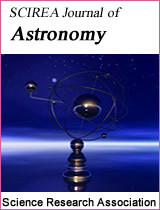IS THE UNIVERSE A SELF-ORGANIZED CRITICALITY SYSTEM?
DOI: 292 Downloads 122855 Views
Author(s)
Abstract
Sandpile Paradigm was proposed by Bak, Tang and Wiesenfeld (Bak et al. 1987) to explain simple model of Self-Organized Criticality (SOC). When the piles fall on the sandpile (input driver), we will see, that at some critical point (reaching adequate angle of response), sand will slide down to get the saturation phase.
The steady driver for Sandpile Paradigm is the gravity. Angle of response plays the role of criticality. Sand avalanches are the energy output. The SOC approach has been already used for interpretation of magnetospheric processes and recently for Auroral Kilometric Radiation (Marek & Schreiber 2017).
Not only astrophysical processes are included to explain by SOC model but also human activities (e.g. trafic jam or stock market's fluctuations). SOC systems exhibits itself as a straight line at a log - log graph.
In this paper I show that the Universe exhibits itself as a SOC system. Data gathered by the Planck i.e. maps of temperature Cosmic Microwave Background have been used for analysis of a number of counts of the CMB as a function of their temperature by Fv software (https://heasarc.gsfc.nasa.gov/ftools/fv/).
Keywords
Self-Organized Criticality, CMB
Cite this paper
Michał Marek,
IS THE UNIVERSE A SELF-ORGANIZED CRITICALITY SYSTEM?
, SCIREA Journal of Astronomy.
Volume 2, Issue 1, June 2018 | PP. 1-4.
References
| [ 1 ] | Aschwanden, M. J., A macroscopic description of self-organized systems and astrophysical applications. Astrophys. J., 782, 54. doi:10.1088/0004-637X/782/1/54, 2014. |
| [ 2 ] | Aschwanden, M.J., Crosby, N.B., Dimitropoulou, M., Georgoulis, M.K., Hergarten, S., McAteer, J., Milovanov, A.V., Mineshige, S., Morales, L., Nishizuka, N., Pruessner, G., Sanchez, R., Sharma, A.S., Strugarek, A., Uritsky, V. (2016), 25 years of self-organized criticality: Solar and astrophysics. Space Sci. Rev. 198, 47. doi 10.1007/s11207-016-0910-5. |
| [ 3 ] | Bak, P., C. Tang, K. Wiesenfeld (1987), Self-organized criticality: an explanation of 1/f noise. Phys.Rev. Letters 59(4): 381-384, doi:10.1103/PhysRevLett. 59.381. |
| [ 4 ] | Marek, M., and R. Schreiber, Is the AKR Cyclotron Maser Instability a self-organized criticality system? In Radio Emissions VIII, edited by G. Fischer, G. Mann, M. Panchenko, and P. Zarka, Austrian Academy of Sciences Press, Vienna, 269 277, 2017. |

